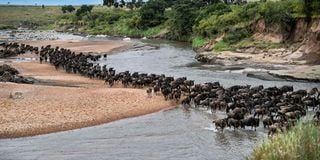Premium
Kenya, Tanzania to jointly protect Mara-Serengeti ecosystem from pollution

Wildebeests arrivat Kenya's Maasai Mara Game Reserve from Tanzania's Serengeti National Park during the start of the annual migration.
Kenya and Tanzania have jointly committed to invest in integrated environmental sanitation and cleaner production for industries in the Mara River Basin to protect this vital transboundary ecosystem from degradation.
The move comes amid a growing threat to the Mara River, which originates in Narok County in Kenya and ends in the Mara region of neighbouring Tanzania.
Lake Victoria Basin Commission (LVBC) Executive Secretary Masinde Bwire said the initiative is part of efforts to address the threats facing the iconic wildebeest migration in the Maasai Mara and Serengeti ecosystems as well as threats to the Lake Victoria Basin.
The proposal, to be presented to the Council of Ministers, suggests stricter regulations for industries operating along the Mara River to ensure production processes and waste disposal do not harm the ecosystem.
“The two countries need to foster a cross-border cooperation in the protection of the vital water source and invest in improved sanitation infrastructure to prevent pollution from human settlements and agricultural activities.
“This will involve building modern sewage treatment facilities and creating awareness among local communities about the importance of protecting water sources,” Dr Bwire said.
In a joint communique, the two countries said the challenges facing the Mara-Serengeti ecosystem and Lake Victoria Basin require concerted efforts by stakeholders of the shared water resource.
“We hereby agree to strengthen the enabling environment for cooperative management of the transboundary Maasai Mara-Serengeti ecosystem,” said part of the 15-point plan.
The report was signed by Kenya’s East African Community (EAC) Principal Secretary Abdi Dubat and Tanzania’s Mara Regional Commissioner Evans Mtambi at the 13th Mara Day Celebrations at Sekenani Town in Narok County last Sunday.
The decision to celebrate Mara Day was made during the 10th Sectoral Council of Ministers for Lake Victoria Basin meeting in 2012 in Kigali, Rwanda. Mara Day is meant to promote conservation efforts and protect the ecosystem from threats such as deforestation, pollution, poaching and climate change.
Despite making significant achievements, deforestation in the Mau water catchment presents a serious threat to Kenya's water security by disrupting vital ecosystems, diminishing water flow to major rivers, and accelerating soil erosion.
Dr Bwire added that poaching in the Mara poses devastating effects on wildlife populations, leading to the decline of key species such as elephants and rhinos.
Mara Day celebrations, which have since been held on a rotational basis between Kenya and Tanzania, are coordinated by LVBC which is also tasked with organising the sustainable development and management of the Lake Victoria Basin across the seven partner states of the EAC.
Located at the border of Kenya and Tanzania, the Mara ecosystem is home to a rich variety of wildlife, including the "Big Five" – lion, leopard, elephant, buffalo and rhino – as well as many species of other mammals, birds, reptiles and insects.
One of the most famous features of the Mara Ecosystem is the annual Great Migration, known as the ‘Seventh wonder of the world’, where millions of wildebeest, zebras, and gazelles migrate from the Serengeti in Tanzania to the Masai Mara in Kenya.
This spectacular event is crucial for the survival of these species and attracts tourists from around the world. This ecosystem also plays a critical role in maintaining ecological balance.





